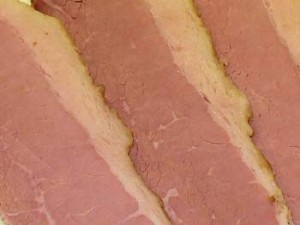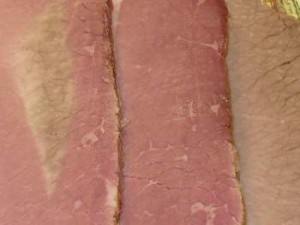What Curing Salt to Use With Conrned Beef

Brining, also known as corning or sweet pickling is a practiced meat curing method for beginners because it is easy and relatively inexpensive to practise with delicious results. To make corned beefiness, you immerse meat in brine, which is simply a solution of salt and h2o. Also table salt and water, at that place are a few other ingredients commonly used in a brining recipe for corned beef brisket.
- Salt preserves the meat, enhances flavor and helps carry saccharide and spices throughout the food.
- Water is the other cardinal ingredient in brine. Utilize distilled or filtered water if possible. If you use tap water, let it stand for 24 hours to dissipate the chlorine, which can interfere with the curing process. Hard water, water softeners, and fluoride too inhibit preservation action.
- Nitrite turns meat a reddish-pinkish color and contributes unique flavor.
- Carbohydrate contributes sweetness and counteracts saltiness. Yous tin can apply any type of saccharide, including granulated, brown, or dextrose. Dextrose is a refined corn sugar that dissolves readily.
- Spices add flavor.
Where'due south the Corn in Corned Beef?
Corning is an old English term that refers to pellets of common salt, called "corns". Therefore, corned beef is simply meat preserved with salt. It has nothing to practice with the vegetable we all know (and love) as corn on the cob.
Best Salt to use for Brining or Curing Meat
Many brining recipes do not specify the type of salt. Even so, pickling or canning table salt is your best choice in brining recipes because it is pure, fine-grained, and dissolves easily. Pickling and canning common salt is available in most major grocery stores and often where canning supplies are sold. Yous tin also order it on this website here. Kosher salt is an adequate substitute, merely coarse grains accept longer to dissolve than fine grains. So get fine grain if yous accept a pick.
Not recommended: table salt and sea salt, because they contain additives or minerals that may inhibit the curing process.
Brining is more than Art than Science
There is no universal brining recipe for curing meat. Weak alkali increases the curing time and strong brine decreases the curing fourth dimension. It is generally recommended to utilise weak alkali for poultry, fish, and game birds, and strong brine for beef, pork, and game meat.
Brine strength is expressed as a percent of table salt in proportion to the weight of the brine. Therefore, when you make brine, y'all measure the common salt in relation to the amount of h2o in the recipe.
Brine Formulas: Weight or Book of Table salt per Quart of H2o
| Brine Force (% Salt) | Whatsoever Salt | MTPC* | MCK** | DK*** |
| v.7% (weak) | 2.0 oz. | three TB. | i⁄4 cup | 6 TB. |
| vii.5% (weak) | two.7 oz. | i⁄four cup + 1 tsp. | 1⁄3 loving cup + 1 tsp. | 1⁄2 loving cup + ii tsp. |
| 15.3% (strong) | 6.0 oz. | 1⁄ii cup + 1½ TB. | 3⁄iv loving cup + one½ tsp. | ane loving cup + iii TB. |
*Morton Tabular array, Pickling, or Canning (MTPC) salt weighs 10 ounces per cup
**Morton Coarse Kosher (MCK) salt weighs 7.7 ounces per cup
***Diamond Kosher (DK) table salt weighs 5 ounces per cup
Good alkali recipes will give you lot the formula using the weight of the salt. If dry measures are given, they tin can be inaccurate unless they also specify the type and make of salt. Measured by weight, five ounces of any type of table salt is equivalent to any other kind. Measured by book, one type of salt may require twice equally much, as the table above shows (DK requires twice equally much by volume than MTCP.)
Determining how long to alkali meat

Under-cured, evenly cured, and uncured beef brisket (photo by Carole Cancler)
Determining how long to brine meat depends on the brine strength, the size and shape of the piece, and the texture of the meat. For weak brine, estimate 3-4 days per pound. For stiff brine, kickoff with two days per pound. If curing time is as well short, you will see uneven color, especially at the center of the meat or under heavy layers of fat. If curing fourth dimension is too long by a few days, y'all should not notice whatever difference.
Note that brining a turkey for Thanksgiving dinner (or whatsoever other meat) for a day or two merely adds flavour. For preserving, the salt and other ingredients must fully displace the water (the preservative action) throughout the meat tissue, then timing needs to be much longer.
Curing Salts (Sodium Nitrate and Sodium Nitrite)
Saltpeter (sodium nitrate) is a naturally occurring mineral that has been used to cure meat for at least one,000 years. Nitrate preserves meat by prohibiting the growth of spoilage bacteria (especially C. botulinum) and preventing fats from going rancid.
Every bit it turns out, nitrate isn't the active amanuensis in meat curing, rather its derivative, nitrite. Nitrite causes the preservative furnishings, besides as the flavory blood-red-pink colour and pleasing flavor that we associate with cured meat. People continued to use nitrates merely until nitrites became readily bachelor. Nitrate is still used today but when a slow-cure method is needed for raw-cured products, such as dry pepperoni, dry out salami, sopressata, and dry coppa.
Curing salt #1 or pinkish curing salt is a "fast" cure that contains sodium nitrite. It is known by various brand names, including InstaCure No. one (formerly Prague Powder #ane), DQ Curing Salt, and tinted curing mix (TCM). The pink colour ensures that users will not confuse it with any other type of table salt. Use cure #one only in products that you volition cook before eating, such as corned beef and bacon. Never substitute pink curing salt for whatsoever other type of table salt.
Tender Quick is a brand of fast curing table salt made by Morton that can exist used to make corned beefiness. Follow the package directions; Tender Quick is not interchangeable with curing salt #1.
Curing salt #2 is a "slow" cure that contains sodium nitrate in addition to sodium nitrite. It may or may not be pinkish colored. Cure #2 is used only for making raw-cured products that are dry-aged for long periods and will not be smoked, canned, cooked, or refrigerated. Cure #2 is non interchangeable with curing common salt #1. Never utilise cure #2 in brine or substitute it for any other type of salt.
You can buy curing salts online through retailers such as butcher-packer.com, mortonsalt.com, and sausagemaker.com.
Because corned beef is cooked after curing, sodium nitrite is not needed to control botulism. Even so, it does impart the characteristic pink colour and flavor. If a pink color is all that is desired, as a little as 40 parts per millions (ppm) or 1 level teaspoon (0.20 ounce) per quart of water achieves the desired result. For preservative effective, more curing salt can be used, up to 200 ppm (ane ounce or five level teaspoons per quart of water), the maximum amount recommended by the USDA for rubber consumption. Sodium nitrite is toxic in large amounts; nether no circumstances should you apply more ane ounce of curing common salt #i per quart of water when making a brining solution.
If y'all don't take or don't want to apply curing table salt containing sodium nitrite, yous can brine meats without it. Without curing salt that contains sodium nitrite, the color of the cured meat volition be gray rather than pink and the flavor is less sugariness with a more pronounced "pickle" flavor. It turns out more similar seasoned roast meat, than a cured meat.
Beef and Game Meat to employ for Corning
The virtually common cut used for corned beef is the brisket or round. Game including antelope, behave, elk, moose, and venison are also excellent meats to preserve by the corned beef brining method. In game meat, brining removes the musky flavor and tenderizes even the toughest meat. Every bit when making corned beef, brisket (lower chest) and round (leg) are good cuts of game meat to use, as well every bit loin, rump, and shoulder. Pork is ordinarily cured by brining, including loin, rump, and shoulder for hams and belly for salary. Lamb and veal do not result in products with good color or flavor, and so are non recommended for brining.
Tips for Brining Meats
- Apply noncorrosive containers and weights such every bit plastic, glass, stainless, or pickling crocks.
- Ready enough brine to encompass meat completely.
- Estimate ane quart of brine for every iv-6 pounds of meat (or 30%-50% brine weight per pound of meat; 1 quart of brine weighs 2 pounds).
- To dissolve salt and sugar more readily, heat half of the quantity of h2o and dissolve the table salt and the sugar completely before calculation the remaining liquid.
- Always arctic brine thoroughly before adding the meat.
- Always cure meat in the refrigerator (<40°F).
- Plow or flip over brining meat in one case or twice daily. Rotation helps meat to cure evenly.
Making corned beef brisket is a proficient meat curing projection for beginners that is like shooting fish in a barrel to do. Corning uses strong brine of salt and water with added carbohydrate and spices for season. A modest amount of pink curing salt containing sodium nitrite too adds characteristic color and flavor.
For more details on the curing food preservation methods with recipes, run into the book The Dwelling Preserving Bible by Carole Cancler, or visit our online Amazon store for more books and equipment useful for curing meat and game products.
jacobsonthelikin93.blogspot.com
Source: http://www.homepreservingbible.com/1160-all-about-brining-and-curing-corned-beef-and-game-meat/
0 Response to "What Curing Salt to Use With Conrned Beef"
Postar um comentário